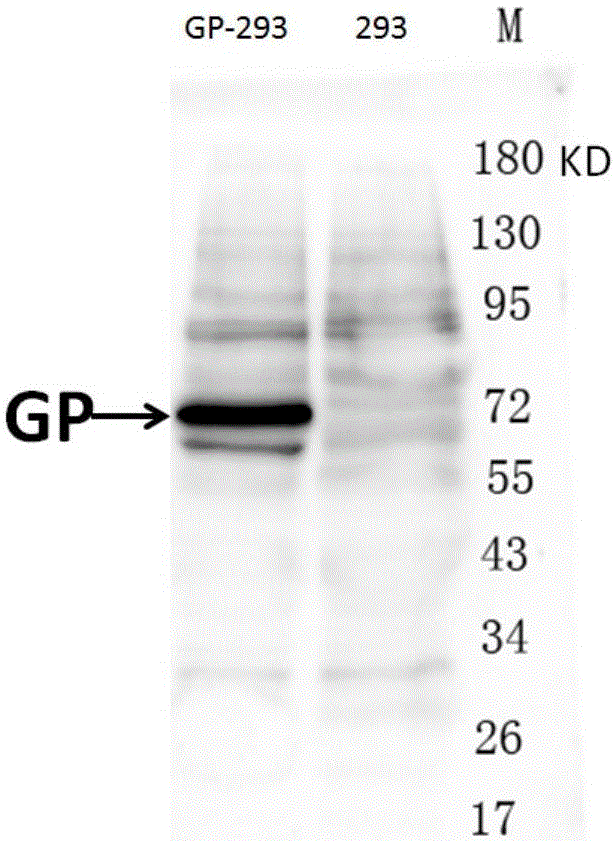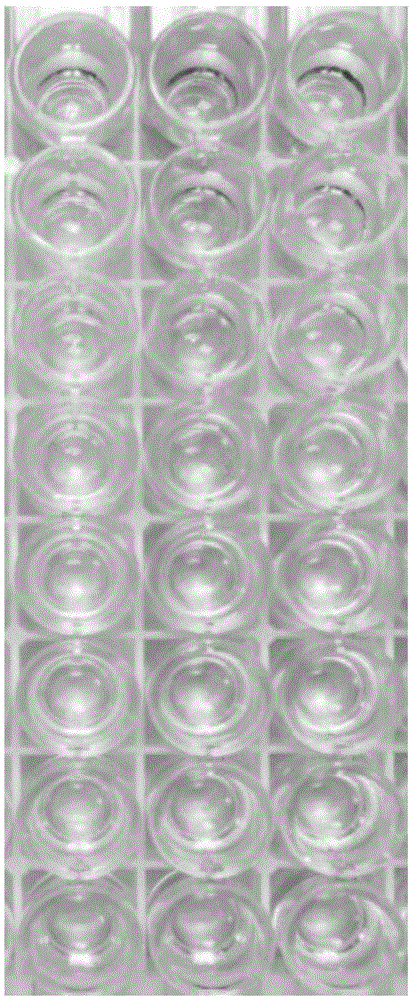Hybridoma cell strain ZJED0-02, anti-Ebola virus GP (glycoprotein) monoclonal antibody and their preparation and application
A hybridoma cell line, Ebola virus technology, applied in the direction of antiviral immunoglobulin, biochemical equipment and methods, material inspection products, etc., can solve the problems of inaccuracy, lack of drugs, limited therapeutic effect, etc., and achieve high Effects of Specificity and Sensitivity
- Summary
- Abstract
- Description
- Claims
- Application Information
AI Technical Summary
Problems solved by technology
Method used
Image
Examples
Embodiment 1
[0035] The preparation of the monoclonal antibody of embodiment 1 anti-Ebola GP protein
[0036](1) Immunization of mice: BALB / C mice aged 6 weeks were selected for immunization. For the first immunization, the 80 peptide of the Ebola virus GP protein (Ebola virus GP protein No. 411-490) cross-linked KLH Amino acid sequence: ADNDSTASDTPATTAAGPLKAENTNTSKSADSLDLATTSPQNYSETAGNNNTHHQDTGEESASSGKLGLITNTIAGVA) and QuickAntibody-mouse5W were mixed uniformly by volume at 1:1. Each BALB / C mouse 0.1ml (20 peptide 100ug of Ebola GP protein), intramuscularly injected into the inner thigh. On the 21st day, a dose of booster immunization was given in the same way. On the 35th day, a small amount of tail blood was collected for ELISA determination, and the antibody titer reached 1:32000, followed by a booster immunization by tail vein injection, and cell fusion was carried out 3 days later.
[0037] Among them, the 80 peptide of the Ebola virus GP protein was synthesized by a solid-phase me...
Embodiment 2
[0045] Embodiment 2 carries out the identification (qualitative) detection of Ebola virus GP protein with this monoclonal antibody
[0046] The anti-Ebola GP protein monoclonal antibody prepared by embodiment 1 can be used for identification (qualitative detection), and the identification method can be realized by the following methods:
[0047] Western Blotting: The Ebola adenovirus recombinant vaccine loaded with Ebola virus GP protein was cultured in HEK-293 cells, and the cultured cell lysate was used for Western Blotting detection with the monoclonal antibody, and the target band appeared at the corresponding position, indicating that the detection to the expression of the Ebola virus GP protein. Specific steps:
[0048] (1) SDS polyacrylamide gel electrophoresis: For the method, refer to F. Osper et al., "A Guide to Molecular Biology Experiments" (Science Press, 1998). Using 10% separating gel and 5% stacking gel, the electrophoresis condition is a voltage of 150V, and...
Embodiment 3
[0052] Embodiment 3 monoclonal antibody detects the sensitivity of Ebola virus GP protein
[0053] The anti-Ebola virus GP protein monoclonal antibody prepared in Example 1 can be used for quantitative detection of the level of various expressed Ebola virus GP proteins, which can be achieved by the following methods:
[0054] Indirect ELISA method:
[0055] ① Properly dilute the test sample in 0.01M pH9.6 carbonate buffer coating solution, 100ul / well, incubate at room temperature for 2h or coat overnight at 4°C.
[0056] ②Empty the liquid and pat dry the residual liquid, wash the plate three times with 0.01MpH7.4PBS-Tween20 washing solution.
[0057] ③ Block with 2% BSA-0.01M PBS at pH 7.2 for 1 hour.
[0058] ④ Wash the plate 3 times as above.
[0059] ⑤Add 1:100 diluted monoclonal antibody, 0.1ml / well, and react at room temperature for 2 hours.
[0060] ⑥After washing the plate 3 times as above, add goat anti-mouse IgM-HRP, 0.1ml / well, and react at room temperature for 1...
PUM
 Login to View More
Login to View More Abstract
Description
Claims
Application Information
 Login to View More
Login to View More - R&D
- Intellectual Property
- Life Sciences
- Materials
- Tech Scout
- Unparalleled Data Quality
- Higher Quality Content
- 60% Fewer Hallucinations
Browse by: Latest US Patents, China's latest patents, Technical Efficacy Thesaurus, Application Domain, Technology Topic, Popular Technical Reports.
© 2025 PatSnap. All rights reserved.Legal|Privacy policy|Modern Slavery Act Transparency Statement|Sitemap|About US| Contact US: help@patsnap.com



